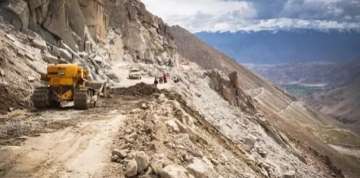BRO using new tech to build all-weather road at one of world's most inhabited place - Daulat Beg Oldie
The Border Roads Organisation (BRO) is using a highly advanced 'micropile technology' for the first time to build an all-weather road to Daulat Beg Oldie (DBO), a forward post along the India-China border in Ladakh, PTI reports quoting officials.

The Border Roads Organisation (BRO) is using a highly advanced 'micropile technology' for the first time to build an all-weather road to Daulat Beg Oldie (DBO), a forward post along the India-China border in Ladakh, PTI reports quoting officials. Daulat Beg Oldi lies near the easternmost point of the Karakoram Range in a cold desert region in the far north of India.
Considering the significance of maintaining all-weather connectivity along the sensitive Indo-China border and facilitating smooth passage of armed personnel and other logistical support, Project Himank has adopted the technology, a first-of-its-kind in Asia, to construct high-altitude roads along the border, the BRO officials claimed.
This technology ensures faster construction and more durable road surfaces, according to the BRO. Micropile or Cementaceous Sub Base (CTSB) technology was also used in the building of the Col Chewang Rinchen Setu, India's highest altitude all-weather permanent bridge, that was inaugurated by Defence Minister Rajnath Singh in eastern Ladakh in October.
The Project Himank is located at one of the highest inhabited place on the globe at 16,696 feet and the road is being constructed in the Leh-Karakoram Pass section between the Himalayan and the Karakoram mountain ranges.
"This (micropile) is a patented technology through which road surface is constructed in an extremely short span of time and the surface is more durable than done through the conventional method," Commander 50-Border Road Traffic Force (BRTF) Col Deepak Baskandi said.
The officials said a 12-km stretch of the DBO road, between kilometre stones 216 to 228, is being constructed using this technology. These kinds of roads are constructed at extremely high-altitude regions over 19,000-feet above sea level and workers at this height are at the risk of getting acute mountain sickness due to the lack of oxygen, they said.
Temperatures fall to minus 50 degrees Celsius in such areas, the officials said, adding that the sector offers a limited window from June to October to execute works.
But, considering the nature of works needed to carve out stable roads in the high seismic zone, conventional methods of construction will take years, much beyond the timelines stipulated for completing projects, they said.
Under the micropile technology, a dry mixture is added to sand and crushed stones.
First the crushed stones and sand are spread on the road surface, and then the admixture is laid ahead of a pulveriser, which rolls over them, mixes them and spreads the components evenly over the road surface, the officials said.
"Through CTSB technology, the road length would be completed within three months. The same length would have been completed in two to three years using the conventional method.
"The road stretch would be more tenacious to withstand harsh climatic conditions prevailing in these terrains," Engineer in-charge Feroz Ahmad was quoted by PTI.
Chief Engineer Project Himank Brig Nitin K Sharma said such techniques can be replicated in other border areas where the conditions for the construction of roads is nearly impossible.
He said in view of the limited working season in Ladakh this technique is a key tool for the BRO. Backed by a team of doctors and paramedics, a huge number of workers and engineers are working against time to complete the construction of the road in the Leh-Karakoram Pass section. The work to realign and rebuild the road began in 2000.
The nature of work on the road to DBO in the Karakoram range includes road formations, re-alignment, widening, retention, metalling and laying of bituminous topping, the officials said. Sharma said the BRO personnel working at a height of 18,000 feet on the 260-km-long DBO axis are facing huge challenges as regards the terrain and cold climatic conditions.
He said the Col Chewang Rinchen bridge was constructed in a record 15 working months after its foundation was laid in 2017, adding that it was built using the innovative micropile technology for the first time in Asia. PTI AB
(With PTI inputs)